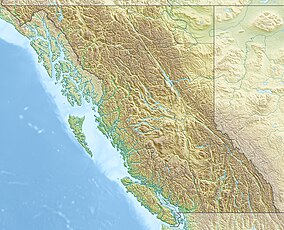
Northern Manitoba is a geographic and cultural region of the Canadian province of Manitoba. Originally encompassing a small square around the Red River Colony, the province was extended north to the 60th parallel in 1912. The region's specific boundaries vary, as "northern" communities are considered to share certain social and geographic characteristics, regardless of latitude.

Kitimat is a district municipality in the North Coast region of British Columbia, Canada. It is a member municipality of the Regional District of Kitimat–Stikine regional government. The Kitimat Valley is part of the most populous urban district in northwest British Columbia, which includes Terrace to the north along the Skeena River Valley. The city was planned and built by the Aluminum Company of Canada (Alcan) during the 1950s. Its post office was approved on 6 June 1952.

The Kitimat Ranges are one of the three main subdivisions of the Coast Mountains in British Columbia, Canada, the others being the Pacific Ranges to the south and the Boundary Ranges to the north.
Dala-Kildala Rivers Estuaries Provincial Park is a provincial park of 452 ha. in British Columbia, Canada. It protects the mouth of the Dala River in Kildala Arm.
Gitnadoiks River Provincial Park is a 58,000 hectare provincial park in British Columbia, Canada. It is centred on the Gitnadoix River, a tributary of the Skeena River in Northwestern British Columbia, 50 km west of Terrace.
Kitwanga Mountain Provincial Park is a provincial park in British Columbia, Canada located on the north side of the Skeena River just west of the Gitxsan community of Kitwanga (Gitwangak).

Lakelse Lake Provincial Park is a provincial park in British Columbia, Canada, located just west of Highway 37 between Terrace and Kitimat. The name is derived from the Coast Tsimshian language word "LaxGyels" - "fresh water mussel", for the mollusk that is found on the bottom of both Lakelse Lake and Lakelse River. Before Lakelse Lake became a provincial park, Hatchery Creek, which runs throughout the park, was the site of a sockeye salmon hatchery operated by the Canadian Government between 1919 and 1936. Lakelse Lake Provincial Park was established on March 16, 1956.
Lakelse Lake Wetlands Provincial Park is a provincial park in British Columbia, Canada, located near the city of Terrace in that province's Skeena Country. It is 1214 ha. in size.
Nalbeelah Creek Wetlands Provincial Park is a provincial park in British Columbia, Canada.

Owyacumish River Provincial Park is a provincial park in British Columbia, Canada.
Weewanie Hot Springs Provincial Park is a provincial park in British Columbia, Canada, located on the east bank of Devastation Channel opposite the north end of Hawkesbury Island, in the Gardner Canal region south of Kitimat on the province's North Coast.

Raft Cove Provincial Park is a provincial park in British Columbia, Canada, located south of San Josef Bay on northwestern Vancouver Island.

Seven Sisters Provincial Park and Protected Area is a provincial park in British Columbia, Canada, protecting part of the Howson Range between Hazelton and Terrace and comprising approximately 27,200 hectares.
Sleeping Beauty Mountain Provincial Park is a provincial park in British Columbia, Canada located northwest of the city of Terrace. It is located in the watershed of the Zymagotitz River.
Stuart River Provincial Park is a provincial park in British Columbia, Canada. It is located in two sections north and northwest of Vanderhoof along the Stuart River southeast of Stuart Lake and the city of Fort St. James. The upper section is located at 54°13′20″N124°00′00″W and comprises c.7391 ha. while the lower, eastern section is centred at 54°03′00″N123°37′00″W and comprises c.3390 ha. and is within the Greater Prince George area. The upper site, which is located around the confluence of the Stuart and Nechako Rivers, includes the site of Chinlac, a Dakelh village whose inhabitants were massacred and enslaved by the Tsilhqot'in of Anahim Lake c. 1745.
CKTK-FM is a Canadian radio station that broadcasts an adult hits format at 97.7 FM in Kitimat, British Columbia. The station is branded as Bounce 97.7. CKTK is owned by Bell Media.
The Nechako Reservoir, sometimes called the Ootsa Lake Reservoir, is a hydroelectric reservoir in British Columbia, Canada that was formed by the Kenney Dam making a diversion of the Nechako River through a 16-km intake tunnel in the Kitimat Ranges of the Coast Mountains to the 890 MW Kemano Generating Station at sea level at Kemano to service the then-new Alcan aluminum smelter at Kitimat. When it was constructed on the Nechako River in 1952, it resulted in the relocation of over 75 families. It was one of the biggest reservoirs built in Canada until the completion of the Columbia Treaty Dams and the W.A.C. Bennett Dam that created Lake Williston. The water level may swing 10 feet between 2790 and 2800 feet.
The Richardson Range is a small subrange of the Kitimat Ranges, located on the southwestern flank of Princess Royal Island east of Kent Inlet, British Columbia, Canada.
Bishop Bay – Monkey Beach Conservancy is a conservancy in British Columbia, Canada. It is 3,374 hectares in size and is accessible only by floatplane or boat. It features boat anchorage and tent platforms as well as a hotspring fed bath house. The temperature of the hotsprings is approximately 41.3 degrees Celsius at the source and about 38.8 degrees Celsius in the bath house. It is located 25 km east of Hartley Bay and 75 km south of Kitimat. The conservancy was established in 2006, with Monkey Beach being added to the conservancy in 2007.
The Kateen River is a river in the Kitimat Ranges of the North Coast region of British Columbia, flowing southwest into the Khutzeymateen River a few miles before its entry to the sea at the head of Khutzeymateen Inlet. The river is within Khutzeymateen Provincial Park.








